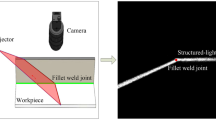Abstract
A narrow-seam identification algorithm is developed to achieve seam tracking in keyhole deep-penetration tungsten inert gas welding (TIG). The welding images are captured by a high-dynamic-range camera and denoised by a bilateral filter based on a noise model analysis. The arc area is extracted as a fixed region of interest. Then, an improved Otsu algorithm and a parabolic fitting algorithm are used to obtain the centerline of the arc. The seam area is extracted as an adaptive region of interest based on a proposed HOG+LBP algorithm. Thereafter, a continuous single-pixel edge contour is extracted by the canny algorithm, and a proposed contour curvature evaluation method is used to obtain the corresponding pixel coordinates. After testing and analysis, the deviation can be reliably detected with an average measurement error within ± 0.04 mm. As a result, the algorithm proposed in this study can accurately identify the deviation during keyhole deep-penetration TIG welding, and has application prospects in the narrow-seam welding field.
Similar content being viewed by others
References
Zhang YM, Kovacevic R (1997) Real-time sensing of sag geometry during GTA welding. J Manuf Sci E-T ASME 119(2):151–160
Zhang YM, Kovacevic R (1998) Neurofuzzy model-based predictive control of weld fusion zone geometry. IEEE T Fuzzy Syst 6(3):389–401
Kiddee P, Fang ZJ, Tan M (2016) An automated weld seam tracking system for thick plate using cross mark structured light. Int J Adv Manuf Technol 87(9–12):3589–3603
Ding Y, Huang W, Kovacevic R (2016) An on-line shape-matching weld seam tracking system. Robot Cim-Int Manuf 42:103–112
Wang XJ, Shi YH, Yu GQ, Liang B, Li Y (2016) Groove-center detection in gas metal arc welding using a template-matching method. Int J Adv Manuf Technol 86(9–12):2791–2801
Shen HY, Wu J, Lin T, Chen SB (2008) Arc welding robot system with seam tracking and weld pool control based on passive vision. Int J Adv Manuf Technol 39:669–678
Ye Z, Fang G, Chen S, Zou JJ (2013) Passive vision based seam tracking system for pulse-mag welding. Int J Adv Manuf Technol 67(9–12):1987–1996
GAO X, Chen Y (2014) Detection of micro gap weld using magneto-optical imaging during laser welding. Int J Adv Manuf Technol 73(1–4):23–33
Yang CL, Guo N, Lin SB, Fan CL, Zhang YQ (2009) Application of rotating arc system to horizontal narrow gap welding. Sci Technol Weld Joi 14(2):172–177
Cui S, Shi Y, Sun K, Gu S (2018) Microstructure evolution and mechanical properties of keyhole deep penetration TIG welds of S32101 duplex stainless steel. Mat Sci Eng A-Struct 709:214–222
Ge J, Zhu Z, He D, Chen L (2005) A vision-based algorithm for seam detection in a PAW process for large-diameter stainless steel pipes. Int J Adv Manuf Technol 26(10):1006–1011
Larson GW, Rushmeier H, Piatko C (1997) A visibility matching tone reproduction operator for high dynamic range scenes. IEEE T Vis Comput Gr 3(4):291–306
GAO J, Qin G, Yang J, He J, Zhang T, WU C (2011) Image processing of weld pool and keyhole in Nd:YAG laser welding of stainless steel based on visual sensing. T Nonferr Metal Soc 21(2):423–428
Xu Y, Fang G, Lv N, Chen S, Zou JJ (2015) Computer vision technology for seam tracking in robotic GTAW and GMAW. Robot Cim-Int Manuf 32(C):25–36
Chang SG, Yu B, Vetterli M (2000) Spatially adaptive wavelet thresholding with context modeling for image denoising. IEEE T Image Process 9(9):1522–1531
Zhang M, Gunturk BK (2008) Bilateral filtering for gray and color images. IEEE T Image Process 17(15):2324–2333
Otsu N (1979) A threshold selection method from gray-level histograms. IEEE T Syst Man Cy B 9(1):62–66
Fitzgibbon A, Pilu M, Fisher RB (1995) Direct least square fitting of ellipses. IEEE T Pattern Anal 21(5):476–480
Kim SJ, Koh K, Lustig M, Boyd S, Gorinevsky D (2008) An interior-point method for largescale l1-regularized least squares. IEEE J Sel Top Quant 1(4):606–617
Xu Y, Yu G, Wang Y, Wu X, Ma Y (2016) A hybrid vehicle detection method based on Viola-Jones and HOG + SVM from UAV images. Sensors-Basel 16(8):1325
Cao X, Wu C, Yan P, Li X (2011) Linear SVM classification using boosting HOG features for vehicle detection in low-altitude airborne videos. Image Processing (ICIP), 18th IEEE International Conference on pp. 2421–2424
Llorca DF, Arroyo R, Sotelo MA (2014) Vehicle logo recognition in traffic images using HOG features and SVM. International IEEE Conference on Intelligent Transportation Systems
Pujol FA, Jimeno-Morenilla A, Sanchez-Romero JL (2017) Face recognition using a hybrid SVM-LBP approach and the Indian movie face database. Curr Sci India accepted 5:974–977
Zou Y, Jiang LP, LI YH, Xue L, Huang JF, Huang JQ (2016) Welding deviation detection algorithm based on extremum of molten pool image contour. Chin J Mech Eng-En 29(1):74–83
Funding
This study is financially supported from the Science and Technology Planning Project of Guangdong Province (grant no. 2015B010919005) and the Science and Technology Planning Project of Guangzhou City (grant no. 201604046026, 201510010230).
Author information
Authors and Affiliations
Corresponding author
Rights and permissions
About this article
Cite this article
Zhang, B., Shi, Y. & Gu, S. Narrow-seam identification and deviation detection in keyhole deep-penetration TIG welding. Int J Adv Manuf Technol 101, 2051–2064 (2019). https://doi.org/10.1007/s00170-018-3089-0
Received:
Accepted:
Published:
Issue Date:
DOI: https://doi.org/10.1007/s00170-018-3089-0




